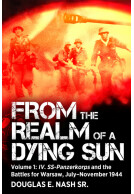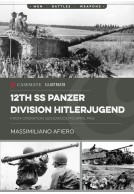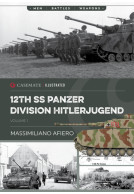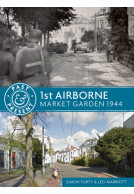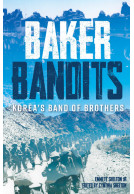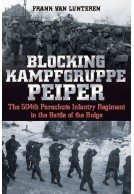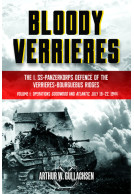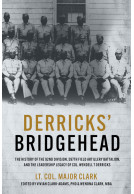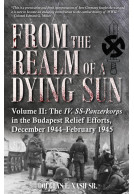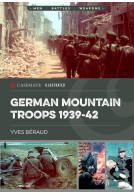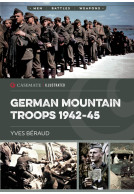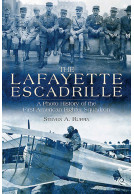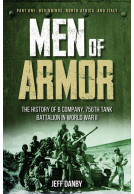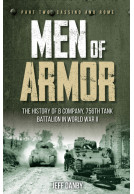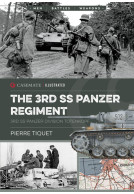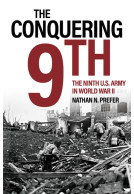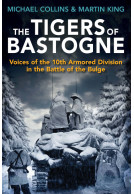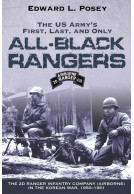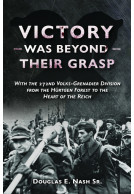Regimental Histories
From the Realm of a Dying Sun (Paperback)
Volume 1: IV. SS-Panzerkorps and the Battles for Warsaw, July–November 1944
A detailed account of Herbert Otto Gille’s IV SS-Panzerkorps that participated in many of the key battles fought on the Eastern Front during the last year of WWII.During World War Two, the armed or Waffen-SS branch of the Third Reich’s dreaded security service expanded from two divisions in 1940 to 38 divisions by the end of the war, eventually growing to a force of over 900,000 men until Germany’s defeat in May 1945. Not satisfied with allowing his nascent force to be commanded in combat by army headquarters of the Wehrmacht, Heinrich Himmler, chief of the SS, began to create his own SS corps and army headquarters beginning with the SS-Panzerkorps in July 1942. As the number of Waffen-SS divisions increased, so did the number of corps headquarters, with 18 corps and two armies being planned or activated by the war’s end.
The histories of the first three SS corps are well known – the actions of I, II, and III (Germanic) SS-Panzerkorps and their subordinate divisions, including the Leibstandarte SS Adolf Hitler, Das Reich, Hitlerjugend, Hohenstaufen, Frundsberg and Nordland divisions, have been thoroughly documented and publicized. Overlooked in this pantheon is another SS corps that never fought in the west or in Berlin but one that participated in many of the key battles fought on the Eastern Front during the last year of the war – the IV SS-Panzerkorps. Activated during the initial stages of the defense of Warsaw in late July 1944, the corps, consisting of both the 3. and 5. SS-Panzer Divisions (Totenkopf and Wiking, respectively) was born in battle and spent the last ten months of the war in combat, figuring prominently in the battles of Warsaw, the attempted Relief of Budapest, Operation Spring Awakening, the defense of Vienna, and the withdrawal into Austria where it finally surrendered to U.S. forces in May 1945.
Herbert Otto Gille’s IV SS-Panzerkorps was renowned for its tenacity, high morale and, above all, its lethality, whether conducting a hard-hitting counterattack or a stubborn defense in situations where its divisions were hopelessly outnumbered. Often embroiled in heated disputes with its immediate Wehrmacht higher headquarters over his seemingly cavalier conduct of operations, Gille’s corps remained to the bitter end one of the Third Reich’s most reliable and formidable field formations.
The Battlin' Bastards of Bravo (Hardback)
Bravo Company, 1/506th, 101st Airborne, in Vietnam and Beyond
The “Battlin’ Bastards” of B Company, 1st Battalion, 506th Infantry Regiment, 101st Airborne Division, fought daily against a well-trained and determined enemy during their tours in Vietnam, 1968–71. Before the war, these men were brothers, sons, sweethearts, husbands, and fathers. Some were athletes, some musicians. Some were just out of high school, some in established careers. There is no monolithic “Battlin’ Bastard,” but when they joined the 101st Airborne Division—one of the most highly decorated divisions in the United States Army—in Vietnam, they united, fighting for each other, and fighting to return safely home.It was difficult to put their experiences behind them. As Bravo veteran, Terry Taylor, recalled, “I learned at the age of 18 that you don’t have to die to go to hell. Vietnam was hell on earth.” And yet despite the obstacles, many of these men built successful lives post-war. Decades after returning from the war, when the men were ready to cautiously revisit their experiences, the Bastards started stateside reunions.
From these reunions came the wish to share their stories with the world, to honor, to educate, and to inspire. The result is this book, written from interviews and diligent archival research, in which the surviving “Battlin’ Bastards” tell their stories of combat in their own words, and honor those who “sacrificed for their country and their unit.”
Additionally, the author of A War of Their Own has requested an update to the long description. Please update the final sentence in the second paragraph to: “In the United States at the time of the fall, he tried to learn their fate with Chickering's help, but Cambodia had become a tomb.”
The Defeat and Attrition of the 12. SS-Panzerdivision "Hitlerjugend", Volume I (Hardback)
The Normandy Bridgehead Battles 7–11 June 1944
Following the Normandy invasion of 6 June, 1944, Heersgruppe B under German Generalfeldmarschall Erwin Rommel rushed reserves to the newly created bridgehead in order to crush it and drive the Allied forces into the sea. One of these armored reserves was the newly created 12. SS-Panzer-Division Hitlerjugend. Extremely well equipped and at near full strength by mid-1944 standards, it was seen as an extremely capable formation that could defeat any Allied invasion.During this period studied in this volume, 7-11 June 1944, the 12. SS-Panzer-Division attempted to capture and hold the battlefield initiative, and in conjunction with other Panzer-Divisionen, throw what would become the Second British Army into the sea. The main thesis presented will be that despite this division's best efforts, it was defeated by a firm Allied defence that repulsed their offensive operations, eventually robbing the Germans of the initiative in a grinding series of bridgehead battles.This first volume will study combat in the period 7-11 June 1944 in the eastern sector of the Normandy Bridgehead. Chapters will analyze the Anglo-Canadian D-Day assault and the deployment of the division, then analyze in detail the fighting of the Hitlerjugend in the following areas: northern Caen, Putot, Bretteville l'Orgueilleuse, Norrey-en-Bessin, Hill 103, Le-Mesnil-Patry, and finally Rots. Also studied will be contrasting German and Anglo-Canadian tactical doctrine, the influence of tactical airpower, and the war crimes committed by the Hitlerjugend immediately after the invasion.The conclusion will reinforce the thesis presented above and a detailed set of appendices will analyze German personnel, equipment, and armored losses during the battles, and losses inflicted on the Allies. This will be Volume 1 of a planned multi-volume commitment.12th SS Panzer Division Hitlerjugend (Paperback)
From Operation Goodwood to April 1945
Formed in 1943 with the express purpose of blocking the forthcoming Allied invasion in the West, the 12th SS Panzer Division Hitlerjugend carved out a reputation as one of the Wehrmacht’s foremost panzer divisions, as witnessed by its tenacious defense of Caen following the Allied invasion of Normandy.The British Operation Goodwood against Caen in July 1944 was followed by Totalize in August, which bypassed Caen and attacked the Hitlerjugend positions. Within a week thousands of German troops were encircled in the Falaise Pocket. Around ten thousand Hitlerjugend soldiers escaped piecemeal, regrouping to fight in the battles along the Maas and the ill-fated Ardennes offensive of December 1944. Deployed to Hungary in 1945 to stem the Red Army advance, the division fought against overwhelming odds until the final battles in Austria, on Reich soil, in late April 1945. There the soldiers of the Hitlerjugend, despite the desperate situation and the superiority of the enemy, managed to achieve local success and launch desperate counterattacks even into the last weeks of the war. Packed with photographs, maps and profiles, this Casemate Illustrated title follows the actions of the 12th SS Panzer Division throughout its existence.
12th SS Panzer Division Hitlerjugend, Volume 1 (Paperback)
Created in 1943 from members of the Hitler Youth born in 1926, the division was attached to I SS Panzer Corps in March 1944 and transferred to Normandy. Based around Caen, it was intended to repel a possible and expected invasion from the sea. When the invasion came in June, it was one of the two closest panzer divisions to the landing beaches. The defensive battles that took place in Normandy, particularly the four battles around the city of Caen, saw the young soldiers of the Hitlerjugend demonstrate determined resistance, conceding only due to being greatly outnumbered. After the battles fought in Normandy, the division was withdrawn first to the Franco-Belgian border, where it was engaged in hard defensive fighting and then to Germany for reorganisation.Other difficult and demanding battles followed during the offensive in the Ardennes, on the Bastogne front, in Hungary and finally the last battles fought in Austria, on the sacred ground of the Reich, where the soldiers of the Hitlerjugend, despite the desperate situation and the superiority of the enemy, managed to achieve local success and launch desperate counterattacks even into the last weeks of the war, in the name and in defense of their homeland. Packed with photographs, maps and profiles, this Casemate Illustrated follows the actions of the 12th SS Panzer Division throughout its existence.
1st Airborne (Paperback)
Market Garden 1944
While the 6th Airborne Division had landed in France on D-Day and covered itself in glory, its counterpart, the 1st Airborne Division, had last seen action during an amphibious assault at Taranto on September 9, 1943, as part of the invasion of Italy. Returned to the UK in December 1943, it was held in reserve during the battle of Normandy and spent three months waiting for action, as plan after plan was proposed and then discarded, such was the speed of the Allied pursuit of the Germans.In September 1944, however, 1st Airborne played a leading role in Operation Market—the air component of Operation Market Garden, an audacious attempt by the Allies to bypass the Siegfried Line and advance into the Ruhr. It was to be 1st Airborne’s last action of the war. Encountering more resistance than expected, including II SS Panzer Corps, the division landed too far from Arnhem bridge, and fought bravely but in vain. Held up en route, particularly at Nijmegen, XXX Corps’ advance to Arnhem stuttered and ran late.After nine days of fighting, 1st Airborne had lost 8,000 men around Arnhem when the survivors retreated across the Lower Rhine to safety. During those nine days, however, they had created a legend: first as the small unit under Lt-Col John Frost held the “bridge too far” and then as the Oosterbeek perimeter came under sustained attack waiting for XXX Corps to arrive.The Past & Present Series reconstructs historical battles by using photography, juxtaposing modern views with those of the past together with concise explanatory text. It shows how much infrastructure has remained and how much such as outfits, uniforms, and ephemera has changed, providing a coherent link between now and then.A Mighty Fortress (Paperback)
Lead Bomber over Europe
A Mighty Fortress is the personal account of the Captain and crew of a lead bomber in the enormous formation raids made by the 8th Airforce during the last few months of World War II. It is an extraordinary tale of heroism and bravery on the part of the whole crew of just one B17 amongst hundreds – but the one B17 that meant most to them. Flying a total of 27 missions before the war came to an end, Alling tells, with great restraint, the story of what it was like to be there, over the skies of enemy territory, constantly on the lookout for enemy fighters.Armies of the Italian Risorgimento (Paperback)
The Italian Risorgimento was the political process that led to the unification of the Italian peninsula into a single kingdom after three bloody wars fought between Piedmont and Austria. It lasted for more than two decades (1848-1870) and was one of the key moments in the history of Europe. In this book, all the Italian military contingents taking part to the campaigns of 1848-1870 will be taken into consideration and thus the armies of the following states will be covered: Piedmont, Kingdom of the Two Sicilies, Papal States, Grand Duchy of Tuscany, Duchy of Modena, and Duchy of Parma. The analysis will not focus only on the regular troops, but also on the armies of the short-lived “Revolutionary States” and on the many volunteer corps that came from abroad in order to fight for the Italian cause. The whole book will be illustrated with a large amount of color plates, showing the uniforms of iconic military units like Piedmontese Bersaglieri and Papal Zouaves.Baker Bandits (Hardback)
Korea's Band of Brothers
B-1-5 was a unique company in the Korean War. The Baker Bandits fought at Inchon, Naktong, Chosin Reservoir, Guerrilla Hunts and the many numbered hills. Theyinspired one B Company Commander, Gen. Charlie Cooper to the extent that when he became Commanding General of the Marines First Division in 1977, his time with B-1-5 inspired his “Band Of Brothers Leadership Principles” used widely in the Corps for many years. Emmett Shelton was a 19-year-old Marine Reservist in 1950. He was called to duty after graduating Austin High School and, within six months, he was a rifleman in Korea. The Korean winter of 1950 was brutal and Emmett was evacuated shortly after Chosin due to frostbite. After the war, Emmett got on with life, then in the 1980s he attended a Chosin Few Reunion. He was overwhelmed by a need to reconnect with his old Company, his Baker Bandits. Emmett tracked down B Company members one-by-one and started a newsletter, The Guidon, to share stories and reconnect. For 20 years Emmett published The Guidon, monthly. The contributing readership grew to a high of 300, including a number of young B Company Marines fighting in Afghanistan. Chosin Brothers brings together first-hand accounts from The Guidon, written by the men of B-1-5 about their time in Korea: their battles, their fallen commanders, deathin the foxhole, lost platoons, injuries and what happened to them after the war.Blocking Kampfgruppe Peiper (Paperback)
The 504th Parachute Infantry Regiment in the Battle of the Bulge
In December 1944 an enormous German army group crashed through the thin American line in the Ardennes forest. Caught by surprise, the Allies were initially only able to throw two divisions of paratroopers to buttress the collapse - the 82nd Airborne, which was rushed to the area of St. Vith, and the 101st, which was trucked to Bastogne. After their successful campaign in Holland, Colonel Reuben Tucker’s elite 504th Parachute Infantry Regiment was resting and refitting in France when news came of the German breakthrough. Most dangerous to the Allies was the German spearhead of the 1st SS Panzer Division led by Jochen Peiper, which aimed to sever the Allied front. The 504th was committed to block the SS advance, and within 48 hours of their arrival Colonel Tucker's paratroopers were attacking the SS-Panzergrenadiers of Peiper’s battlegroup, eventually forcing them to withdraw. More ferocious fighting ensued as follow-up German units forced a U.S. retreat from St. Vith. In adverse weather conditions against the German 9th SS Panzer and 3rd Fallschirmjäger Divisions, the 504th lived up to it's regimental motto - Strike and Hold. Although some rifle companies were whittled down to less than 50 paratroopers, the Americans doggedly fought on until victory was achieved. Moving quotations of letters to the next-of-kin provide insight into the impact of their deaths both on the battlefield and homefront.In this work Van Lunteren provides a fascinating, close-in view of the 504th P.I.R. during the Battle of the Bulge as well as its gallant sacrifice. Using never before published diaries, letters, battle reports and interviews with over 100 veterans, a comprehensive account is painted of a triumphant U.S. regiment in one of the fiercest fought campaigns in the history of the U.S. Army.
Bloody Verrieres: The I. SS-Panzerkorps' Defence of the Verrières-Bourguebus Ridges (Hardback)
Volume I: Operations Goodwood and Atlantic, 18-22 July 1944
South of the Norman city of Caen, the twin features of the Verrières and Bourguebus ridges were key stepping stones for the British Second Army in late July 1944 - taking them was crucial if it was to be successful in its attempt to break out of the Normandy bridgehead. To capture this vital ground, Allied forces would have to defeat arguably the strongest German armoured formation in Normandy: the I. SS-Panzerkorps "Leibstandarte." The resulting battles of late July and early August 1944 saw powerful German defensive counterattacks south of Caen inflict tremendous casualties, regain lost ground and at times defeat Anglo-Canadian operations in detail. Viewed by the German leadership as militarily critical, the majority of its armored assets were deployed to dominate this excellent tank country east of the Orne river. These defeats and the experience of meeting an enemy with near-equal resources exposed a flawed Anglo-Canadian offensive tactical doctrine that was overly dependent on the supremacy of its artillery forces. Furthermore, weaknesses in Allied tank technology inhibited their armored forces from fighting a decisive armored battle, forcing Anglo-Canadian infantry and artillery forces to further rely on First World War "Bite and Hold" tactics, massively supported by artillery. Confronted with the full force of the Panzerwaffe, Anglo-Canadian doctrine at times floundered. In response, the Royal Artillery and Royal Canadian Artillery units pummelled the German tankers and grenadiers, but despite their best efforts, ground could not be captured by concentrated artillery fire alone. This is a detailed account of the success of I. SS-Panzerkorps' defensive operations, aimed at holding the Vèrrieres-Bourgebus ridges in late July 1944.Derricks' Bridgehead (Hardback)
597th Field Artillery Battalion, 92nd Division, and the Leadership Legacy of Col. Wendell T. Derricks
The 597th Field Artillery Battalion, 92nd Division, was the first, last, and only all-black officered direct support field artillery battalion committed to combat in the history of the U.S. Army. It was the first all-black unit in a combat division and, together with the 600th Field Artillery Battalion, constituted the only all-black units in any combat division. Alongside impressive achievements on the battlefield in Italy in 1944–45, the unit provided more key command and staff positions exclusively for black field artillery officers than any other U.S. Army unit in combat, giving combat training and experience to more senior black field artillery officers than any of the other 16 black field artillery battalions during World War II.Colonel Wendell Derricks worked to shelter his troops from the worst of the racism exhibited during the war and, due to his ability to envision an integrated post-war army, he provided unique leadership opportunities for his senior officers. The alumni of the 597th Field Artillery Battalion have an impressive record of success; many of them were inducted into the Field Artillery Hall of Fame, some served at the Pentagon, including Lieutenant Colonel Clark, and others forged successful career in the civilian world.
Fighting Fox Company (Paperback)
The Battling Flank of the Band of Brothers
Easy Company of the 506th Parachute Infantry Regiment of the 101st Airborne Division has become one of the most famous small units in U.S. history, thanks to Stephen Ambrose’s superb book Band of Brothers, followed by portrayals in film. However, to date little has been heard of Fox Company of that same regiment—the men who fought alongside Easy Company through every step of the war in Europe, and who had their own stories to tell.Notably this book, over a decade in the making, came about for different reasons than the fame of the “Band of Brothers.” Bill Brown, a WWII vet himself, had decided to research the fate of a childhood friend who had served in Fox Company. Along the way he met Terry Poyser, who was on a similar mission to research the combat death of a Fox Company man from his hometown. Together, the two authors proceeded to locate and interview every surviving Fox Company vet they could find. The result was a wealth of fascinating first-hand accounts of WWII combat as well as new perspectives on Dick Winters and others of the “Band,” who had since become famous.
Told primarily through the words of participants, Fighting Fox Company takes the reader through some of the most horrific close-in fighting of the war, beginning with the chaotic nocturnal paratrooper drop on D-Day. After fighting through Normandy the drop into Holland saw prolonged ferocious combat, and even more casualties; and then during the Battle of the Bulge, Fox Company took its place in line at Bastogne during one of the most heroic against-all-odds stands in U.S. history.
As always in combat, each man’s experience is different, and the nature of the German enemy is seen here in its equally various aspects. From ruthless SS fighters to meek Volkssturm to simply expert modern fighters, the Screaming Eagles encountered the full gamut of the Wehrmacht. The work is also accompanied by rare photos and useful appendices, including rosters and lists of casualties, to give the full look at Fox Company, which has long been overdue.
From the Realm of a Dying Sun. Volume 2 (Hardback)
Volume II: The IV. SS-Panzerkorps in the Budapest Relief Efforts, December 1944-February 1945
On Christmas Eve 1944, the men of the IV SS-Panzerkorps were preparing to celebrate the occasion as best they could. Taking advantage of the pause in the fighting around Warsaw, they looked forward to partaking in that most German of holidays, including the finest Christmas dinner their field kitchens could still prepare in this fifth year of the war. They had earned it too; after five months of unrelenting combat and the loss of many of their friends, troops from the corps headquarters, headquarters troops, and its two divisions - the 3rd SS Panzer Division “Totenkopf” and the 5th SS Panzer Division “Wiking” - were eagerly anticipating what the holiday would bring, including presents from home and perhaps sharing a bottle of schnapps or wine with their comrades.This was not to be, for that very evening, the corps commander, SS-Obergruppenführer Herbert Otto Gille, received a telephone call notifying him that the 35,000 men of his corps would begin boarding express trains the following day that would take them from the relative quiet of the Vistula Front to the front lines in Hungary, hundreds of kilometers away. Their mission: Relieve Budapest! Thus would begin the final round in the saga of the IV SS-Panzerkorps. In Hungary, it would play a key role in the three attempts to raise the siege of that fateful city. Threatened as much by their high command as by the forces of the Soviet Union, Gille and his troops overcame seemingly insurmountable obstacles in their attempts to rescue the city’s garrison, only to have their final attack called off at the last minute. At that moment, they were only a few kilometers away from the objective towards which they had striven for nearly a month. After the relief attempt’s failure sealed the fate of hundreds of thousands of Hungarians and Germans, the only course of action remaining was to dig in and protect the Hungarian oilfields as long as possible.
German Mountain Troops 1939-42 (Paperback)
Fifteen elite mountain divisions and a multitude of small units fought for the Wehrmacht during World War II. They fought on all fronts, operating in hostile environments ranging from the far north to Libya, the Atlantic to the Caucasus - serving in all the “hot spots.” This book, the culmination of some four decades of research and the support of many veterans and collectors, describes the life, operations and equipment of these specialist units.German Mountain Troops 1942-45 (Paperback)
When World War II began, the Wehrmacht had fifteen mountain divisions and a multitude of small units, including some Austrian units that had been incorporated into the German army after the Anschluss. These mountain units would operate in hostile environments on all fronts during World War II. Due to their training, equipment and adaptability, the Gebirgstruppen would be deployed to fight in almost every theater. In the last years of the war they would see action in North Africa, Italy, the Balkans, Norway and Finland, and in the West as the Allies pushed German forces back toward Berlin.This book, the culmination of four decades of research and the support of many veterans and collectors, describes the uniform, equipment, and operations of these specialist units during the later years of World War II. The text is complemented by period photographs taken at the front, including many color photographs, and modern photographs of uniform details.
Lafayette Escadrille (Paperback)
The Lafayette Escadrille was an all-volunteer squadron of Americans who flew for France during World War I. One hundred years later, it is still arguably the best-known fighter squadron ever to take to the skies. In this work the entire history of these gallant volunteers - who named themselves after the Marquis Lafayette, who came to America’s aid during its Revolution - is laid out in both text and pictorial form. In time for the centennial celebration, this work not only tells the fascinating story of the Lafayette Escadrille, it shows it.Already a student of the squadron, the author spent a full year sifting through university and museum archives in the United States and France for photographs and documents relating to the famed unit. To complement these images, he traveled extensively, taking snapshots of existing markers and memorials honoring the men of the Lafayette Escadrille. In France, he specifically sought out locations where the squadron operated and its pilots frequented. In several cases, he was able to match his present-day color photos with contemporary images of the same scene, thus creating a unique then-and-now comparison. To add even more color, the author included artwork and aircraft profiles by recognized illustrators, along with numerous full-color photographs of artifacts relating to the squadron's men and airplanes, as they are displayed today in various museums in the United States and France.
The result is undoubtedly the finest photographic collection of the Lafayette Escadrille to appear in print. Along with the expert text revealing air-combat experiences as well as life at the front during the Great War, it is a never-before-seen visual history that both World War I aviation aficionados and those with a passing interest in history will appreciate.
Men of Armor: The History of B Company, 756th Tank Battalion in World War II (Hardback)
Part 1: Beginnings, North Africa, and Italy
After the shocking fall of France in June 1940, the U.S. Army embarked on a crash program to establish a new armored force. One of the units formed was the 756th Tank Battalion (Light), activated at Fort Lewis in June 1941. Because of severe equipment shortages, the new battalion trained without tanks for several months, but by early 1942 were equipped with new M3 light tanks. While companies A and C took part in Operation Torch, B was withheld for lack of cargo space in the transport ships and re-joined the battalion two months later in north Africa. The units undertook reconnaissance missions following the landings in Salerno.In December 1943 the battalion was ordered to upgrade to a medium tank (Sherman) unit. Given less than a month to reorganize and train in M4s, the battalion was sent into the Mignano Gap on January 11, 1944 and supported the 34th Infantry Division in the capture of Cervaro and Monte Trocchio. Later in January B Company supported the troops of the 100th Battalion on bloody but ill-fated attempts to cross the Rapido river - finally at the third attempt the battalion established a secure bridgehead across the Rapido. During the next two days the nearby town of Caira was also captured, opening a clear avenue for an attack on Cassino.
Based on decades of research, and hours of interviews with veterans of the 756th Tank Battalion, Jeff Danby's vivid narrative puts the reader in the turret of B Company's Shermans as they ride into battle.
Endorsements:
“This is an excellent, in-depth, day-to-day account of the operations of one tank company of a US independent tank battalion, B Company, 756th Tank Battalion, in World War II… With its focus on tank crew members and their commanders this is a unique addition to the literature on WWII.”
––A. Harding Ganz, Associate Professor Emeritus of the Ohio State University at Newark, author of Ghost Division
“It is very rare to find a book that takes the reader down to the close and personal level of a company of men in battle. We have seen that for paratroopers in Band of Brothers and now we have it for a tank unit, in this case Company B of the 756th Tank Battalion. And what a remarkable book it is … the book is very hard to put down and by the end of it I found myself looking forward to reading the next volume.”
––Jeffrey Plowman, author of Rampant Dragons: New Zealander’s Experience in Armour in World War II, Tank Attack at Monte Cassino: The Cavendish Road Operation 1944 and The Battles for Cassino Then and Now
“[Danby] brings all his considerable skills to this unique Battalion level history. No lead is left unfollowed and this adds not only to the legitimacy of his work but also tells the personal story of these valiant men … It may be the best US armored unit history ever put together so long after the conflict … For the small unit historian of the Armored Units of the Second World War, I cannot recommend this book more highly.”
––Victor Failmezger, author of American Knights, the Untold Story of the Legendary 601th Tank Destroyer Battalion
“Jeff Danby weaves an empathetic tale of people in his history of Company B, 756th Tank Battalion. From the very start, he frames portentous global events in terms of how the young men who would fight the war would have seen them. Danby’s prose is punchy, visually evocative, and entertaining.”
––Harry Yeide, author of The Tank Killers, The Infantry’s Armor, and Steeds of Steel
“Danby introduces and develops an extensive cast of personalities, average American soldiers, as they experience combat and the quiet periods in-between, and gives the reader precious insight in to why this unit was so combat proficient. Jeff has written another great story which I recommend to everyone interested in WWII and especially tank units in that war.”
––LTC Timothy R. Stoy, U.S. Army, retired, served 31 years in the U.S. Army as an Infantry and Foreign Affairs Officer. Historian for the Society of the 3rd Infantry Division (2007–2017) and currently Historian of the 15th Infantry Regimental Association since 1997.
Men of Armor: The History of B Company, 756th Tank Battalion in World War II (Hardback)
Part 2: Cassino and Rome
This second of two volumes recounts the WWII history of B Company, 756th Tank Battalion in vivid detail. The outfit, since upgraded from M5 light tanks to M4 'Sherman' mediums, claws through some of the toughest battles of WWII – from a horrific stalemate at Cassino in February 1944, through the bloody Operation Diadem May breakout, to the stunning capture of Rome on 4th June 1944.This unique multi-volume history covers the full spectrum of experiences of the men in one tank company from inception in June 1941 through the occupation of Germany in 1945. An American tank company in WWII consisted of only five officers and approximately 100 enlisted men – all living, travelling and fighting in seventeen tanks, two jeeps, one truck, one half-track and one tank retriever. Uniting the official record with the rich, personal accounts of the participants, this volume sweeps the reader along a highly detailed and shocking journey chronicling the evolution of American armour doctrine and tank design from June 1941 through to VE Day.
The B Company tankers often fought at a disadvantage – struggling to survive a myriad of battlefield challenges and triumph against enemy armour better armed and better protected. What was once envisioned as a warfare of sweeping armoured formations managed by West Point lieutenant colonels and ROTC captains quickly devolved into small unit street fights relying more and more on the initiative, resourcefulness and cunning of lowly OCS lieutenants and combat-seasoned sergeants. The journey is long, unforgiving and brutal, and 47 tankers would be lost along the way.
Panzer Operations (Paperback)
Germany's Panzer Group 3 During the Invasion of Russia, 1941
Hermann Hoth led Germany’s 3rd Panzer Group in Army Group Center - in tandem with Guderian’s 2nd Group - during the invasion of the Soviet Union in 1941. Together those two daring panzer commanders achieved a series of astounding victories, encircling entire Russian armies at Minsk, Smolensk, and Vyazma, all the way up to the very gates of Moscow.In this work, originally published in German in 1956, Hoth discusses his exact command decisions during Barbarossa - still the largest continental offensive ever undertaken - to reveal new insights into how Germany could, and in his view should, have succeeded in the campaign.
Hoth analyses the origin, development, and objective of the plan, and presents the situations confronted, the decisions taken, and the mistakes made by the army’s leadership, as the new form of mobile warfare startled not only the Soviets but the German leadership itself, which failed to provide support infrastructure for their panzer arm’s breakthroughs.
Hoth sheds light on the decisive and ever-escalating struggle between Hitler and his military advisers on the question whether, after the Dnieper and the Dvina had been reached, to adhere to the original idea of capturing Moscow. He then finally considers in detail whether the Germans, after obliterating the remaining Russian armies facing Army Group Center in Operation Typhoon, could still hope for the occupation of the Russian capital
Hoth concludes his study with several lessons for the future offensive use of armored formations. His firsthand analysis is vital reading for every student of World War II.
Rome to the Po River (Hardback)
The 362nd Infantry Division, 1944–45
In late 1943, 362. Infanterie-Division was formed around the remnants of 268. Infanterie-Division, which had been disbanded after high casualties on the Eastern Front. It fought at Anzio in early 1944, overrun when the Allied broke through the German lines in April. During its time at Anzio, the division was involved in the Benedicta massacre.The unit was withdrawn to Rome. Facing the Allied advance, it suffered further losses and had to be rebuilt once more. Returning to the front, it then fought until late April 1945, when it surrendered.
This account focuses on the efforts of 362. Infanterie-Division to turn back the Allied forces from their advance north in late 1944 and early 1945. Its commander, Heinz Greiner led the division in a series of counterattacks against Allied forces outside Rome that slowed Allied progress.
While Greiner did not have access to the unit war diary while writing this account his experience as commander of 362. Infanterie-Division thoughout this period means that it offers a unique insight into the battle from the German perspective well as a thorough account of the reestablishment, training and combat performance of a German division.
The 3rd SS Panzer Regiment (Paperback)
3rd SS Panzer Division Totenkopf
The 3rd SS Panzer Regiment was part of the Totenkopf Division—one of the 38 Waffen-SS divisions active during World War II. Notorious for its brutality, most notably a mass execution of British prisoners in the battle of France, “Totenkopf” had a fearsome reputation. The 3rd SS Panzer Regiment was formed in France in late 1942, and transferred to the Eastern Front in early 1943 where it fought for the rest of the war.The regiment participated in a number of battles, and would be reduced and rebuilt a number of times. The panzers of 3rd SS Panzer Regiment fought at Kharkov, took part in Operation Citadel, fought in the battle of Krivoi Rog, and the relief of the Korsun Pocket. The regiment then retreated over the Dniester. They fought in Poland against the Russian advance, before being moved to Hungary where they participated in the attempt to relieve Budapest. They eventually surrendered in Czechoslovakia to the 11th US Armored Division.
This Casemate Illustrated tells the story of the 3rd SS Panzer Regiment through the words of the veterans themselves, illustrated with a wealth of contemporary photographs, original documents and artifacts. Among the veterans whose accounts are included are Walter Weber, a member of a tank crew in 5. Kompanie who recounts their optimism and high spirits at the start of Operation Citadel as the Germans made initial advances, followed by retreat as winter set in and the Russians began to push them back. Unterscharführer Stettner recalls the fierce tank battles and the difficulties advancing across minefields and evading an often well-concealed foe. Corporal Fritz Edelmann records the attempts to relieve Budapest in 1945 that Totenkopf took part in, which ended in encirclement, defeat and surrender to the Americans on May 9, 1945.
The Blackhorse in Vietnam (Paperback)
The 11th Armored Cavalry Regiment in Vietnam and Cambodia, 1966–1972
The story of how the 11th Armored Cavalry overcame the perception that Vietnam was an infantry war, and demonstrated what armor could do in an insurgency.Finalist, 2020 Army Historical Foundation Distinguished Writing AwardsWhen the 11th Armored Cavalry Regiment came ashore at Vung Tau, South Vietnam, in September 1966, it faced a number of challenges. The enemy—Viet Cong (VC) and North Vietnamese Army (NVA)—was, of course, the most critical challenge. But the terrain and weather were also factors that could adversely affect the employment of both armored vehicles and helicopters alike. The dearth of doctrine and tactics for the employment of armored cavalry in a counterinsurgency was equally challenging—especially during the pre-deployment training and initial combat operations.But just as importantly, there was an institutional bias within the Army that an insurgency was an infantryman’s war. Despite the thick jungle and monsoonal rains, despite the lack of doctrinal guidance, Blackhorse leaders found a way to overcome the obstacles and accomplish the mission. Within a year of their arrival in Vietnam, Blackhorse troopers overcame ambushes that featured volleys of anti-tank weapons, multitudes of mines, and coordinated assaults by reinforced enemy regiments against troop-sized positions. They defeated an entire enemy division twice their size. Most importantly, the 11th Cavalry successfully demonstrated the ability to operate on and off the roads, in the jungle, and during both the wet and dry seasons. By the spring of 1967, Army leaders were beginning to realize the value of armored forces in Vietnam. With the Blackhorse Regiment leading the way, armor was considered an essential part of the combat team.This is a history of the Blackhorse Regiment in the Vietnam War, and the stories of some of the 20,000 young Americans who served in its ranks during the war.
The Conquering Ninth (Hardback)
The Ninth U.S. Army in World War II
The Ninth Army came into existence in May 1944, under the command of General William Hood Simpson, himself a rather unknown but highly successful ground commander. By late August, the Ninth Army was ready to join the crusade in Europe. Known by its radio call sign "Conquer," they landed at Utah Beach, France, on August 28 and 29. They were now at war and ready for their first assignment. It entered the fray in Brittany, taking over from the Third Army. The biggest port in Brittany was Brest, and operations to capture it began mid-August, with the Ninth Army completing what General Patton had begun by late September. The Ninth Army then moved to the Siegfried Line alongside the First Army. After some inter-army political maneuvering, it was moved to the north flank of the American lines and was the only American army to fight under British Field Marshal Montgomery’s command for several months, until the Rhine River was crossed, playing a small supportive role in the Battle of the Bulge. It went on to be involved in the reduction of the Wesel Pocket in cooperation with the British; the Rhine Crossing, including Operation Varsity, the airborne drop across the Rhine, the reduction of the Ruhr Pocket, and then the"Race to Berlin." The Ninth reached the Elbe River before it was stopped not by the enemy, but by high command. Following the end of hostilities the army was eventually dissolved, and the book covers the dissolution and the subsequent fate of some of its leaders.This new history of the Ninth places the contribution of this unsung army into a full history of the war in Europe in 1944-45. It covers all levels of the army’s activities from the responsibilities and duties of the higher echelon, the commanders through to combat stories of the units under its command and Medal of Honor actions.
The Devil's Playground (Hardback)
The Story of Two Charlie and the Arghandab River Valley
“The Devil’s Playground” was anything south of the second canal to the men of Charlie Company’s 2nd Platoon—Two Charlie—during their 2009–2010 deployment to the Arghandab River Valley in Afghanistan. The valley had been a notorious hot spot throughout history, with the Russians unable to maintain a foothold in the 80s and Coalition forces now facing the same problem during Operation Enduring Freedom.The Two Charlie paratroopers deployed as part of the 2-508th PIR, Two Fury, of the 82nd Airborne Division, but always seemed to be on their own. They started their deployment attached to Canadian forces in Panjwai but were shortly moved into the Arghandab with one of the battalion’s biggest Areas of Operation. They inherited a bare bones outpost that they worked hard to turn into the defendable position known as COP Tynes, while patrolling the grape fields and orchards of the valley. Little did they know that when the leaves returned to the valley in the spring, so too would the fighting.
As the fighting picked up in the valley, the men of Two Charlie continued to sustain casualties as they fought day in and day out. There was never a dull moment in the Arghandab, and the fact that Two Charlie had to patrol, act as a quick reaction force, and secure their outpost on their own ensured that they never stopped. The men were constantly brought to their breaking point as their numbers dwindled and the fighting intensified. The men all started to believe that they weren’t going to make it out of the valley alive. The one rule of the valley would be proved time and time again: in the end, the valley always wins.
This book shares the story of the men of Two Charlie and their fight for survival in the Arghandab River Valley, the Devil’s Playground.
The Fighting 30th Division (Paperback)
They Called Them Roosevelt's SS
In World War I the 30th Infantry Division earned more Medals of Honor than any other American division. In World War II it spent more consecutive days in combat than almost any other outfit. Recruited mainly from the Carolinas and George and Tennessee, they were one of the hardest-fighting units the U.S. ever fielded in Europe. What was it about these men that made them so indomitable? They were tough and resilient for a start, but this division had something else. They possessed intrinsic zeal to engage the enemy that often left their adversaries in awe. Their U.S. Army nickname was the "Old Hickory" Division. But after encountering them on the battleifled, the Germans themselves came to call them "Roosevelt’s SS."This book is a combat chronicle of this illustrious division that takes the reader right to the heart of the fighting through the eyes of those who were actually there. It goes from the hedgerows of Normandy to the 30th's gallant stand against panzers at Mortain, to the brutal slugs around Aachen and the Westwall, and then to the Battle of the Bulge. Each chapter is meticulously researched and assembled with accurate timelines and after-action reports. The last remaining veterans of the 30th Division and attached units who saw the action firsthand relate their remarkable experiences here for the first, and probably the last time. This is precisely what military historians mean when they write about "fighting spirit."
There have been only a few books written about the 30th Division and none contained direct interviews with the veterans. This work follows their story from Normandy to the final victory in Germany, packed with previously untold accounts from the survivors. These are the men whose incredible stories epitomize what it was to be a GI in one of the toughest divisions in WWII.
The Tigers of Bastogne (Paperback)
Voices of the 10th Armored Division During the Battle of the Bulge
The gallant stand of the 101st Airborne Division at Bastogne has long become part of historical and media legend. But how many students of the war realize there was already a U.S. unit holding the town when they arrived? And this unit—the 10th Armored Division—continued to play a major role in its defense throughout the German onslaught.The Us Army's First, Last, And Only All-Black Rangers (Paperback)
The 2d Ranger Infantry Company (Airborne) in the Korean War, 1950-1951
The 2d Ranger Infantry Company (Airborne) was the first and only all-black Ranger unit in the history of the United States Army. Its ten-month lifespan included selection, training, and seven months of combat deployment in Korea, after which the unit was deactivated. Edward Posey’s magnificent new study, now available in paperback, is the first complete history of this elite, all-volunteer unit, whose members were drawn from the 3rd Battalion of the 505th Airborne Infantry Regiment and the 80th Airborne Anti-Aircraft Battalion.The event that propelled the 2d Rangers into the record books was their airborne assault near Munsan-Ni on March 23, 1951—the first in Ranger history. Once on the ground, Posey and his comrades attacked and captured Hill 151. The fighting—often conducted at very close quarters, and some of it with the bayonet and rifle butt—demonstrated the courage of these tough African American soldiers. Heavy fighting marked their months at the front, including a magnificent attack and defense of Hill 581 that May. Throughout their deployment in Korea, the 2d Rangers served with honour and achieved an outstanding combat record.Posey’s long overdue book (written with the help of other Rangers) is based upon the firsthand experiences of many members of the unit, official records, interviews with survivors, and other archival material. Stitched together, this information offers a rich and worthy addition to the growing literature on the Korean War by explaining the obstacles these patriotic African Americans faced, their sacrifices, and their courageous actions on the far side of the world.Victory Was Beyond Their Grasp (Paperback)
With the 272nd Volks-Grenadier Division from the Hürtgen Forest to the Heart of the Reich
As the Allies were approaching the German frontier at the beginning of September 1944, the German Armed Forces responded with a variety of initiatives designed to regain the strategic initiative. While the "Wonder Weapons" such as the V-1 flying bomb, the V-2 missile and the Messerschmitt Me-262 jet fighter are widely recognized as being the most prominent of these initiatives upon which Germany pinned so much hope, the Volks-Grenadier Divisions (VGDs) are practically unknown. Often confused with the Volkssturm, the Home Guard militia, VGDs have suffered the undeserved reputation as second-rate formations, filled with young boys and old men suited to serve only as cannon fodder. This groundbreaking book, now reappearing as a new edition, shows that VGDs were actually conceived as a new, elite corps loyal to the National Socialist Party composed of men from all branches of Hitler's Wehrmacht and equipped with the finest ground combat weapons available.Whether fighting from defensive positions or spearheading offensives such as the Battle of the Bulge, VGDs initially gave a good account of themselves in battle. Using previously unpublished unit records, Allied intelligence and interrogation reports and above all interviews with survivors, the author has crafted an in-depth look at a late-war German infantry company, including many photographs from the veterans themselves. In this book we follow along with the men of the 272nd VGD's Fusilier Company from their first battles in the Huertgen Forest to their final defeat in the Harz Mountains. Along the way we learn the enormous potential of VGDs . . . and feel their soldiers' heartbreak at their failure.
Among Douglas Nash's previous works is Hell's Gate: The Battle for the Cherkassy Pocket, January-February 1944, a work unsurpassed for insight into the other side of the hill in WWII.
Vitebsk (Hardback)
The Fight and Destruction of the 3rd Panzer Army
The city of Vitebsk in Belarus was of strategic importance during the fighting on the Eastern Front, as it controlled the route to Minsk. A salient in the German lines, Vitebsk had been declared a Festerplatz—a fortress town—meaning that it must be held at all costs. a task handed to 3rd Panzer Army in 1943.Otto Heidkämper was chief of staff of Georg-Hans Reinhardt's 3rd Panzer Army, Army Group Center, which was stationed around Vitebsk and Smolensk from early 1942 until June 1944. His detailed account of the defense of Vitebsk through the winter of 1943 into 1944, right up to the Soviet summer offensive a valuable first-hand account of how the operations around Vitebsk played out. Twenty maps accompany the narrative. During this time 3rd Panzer Army undertook numerous military operations to defend the area against the Soviets; they also engaged in anti-partisan operations in the area, deporting civilians accused of supporting partisans and destroying property.
Finally, in June 1944, the Soviets amassed four armies to take Vitebsk, which was then held by 38,000 men of 53rd Corps. Within three days Vitebsk was encircled, with 53rd Corps trapped inside. Attempts to break the encirclement failed, and resistance in the pocket broke down over the next few days. On June 27, the final destruction of German resistance in Vitebsk was completed. Twenty thousand Germans were dead and another 10,000 had been captured.
War's Nomads (Hardback)
A Mobile Radar Unit in Pursuit of Rommel during the Western Desert Campaign, 1942-3
War’s Nomads is an evocative account of one man’s experience of life in a mobile radar unit after the battle of El Alamein as Rommel’s AfrikaKorps was relentlessly pursued across the desert through Egypt, Libya and Tunisia by the Eighth Army. It is the only known detailed account in existence of the small radar units who played a key part in the Western Desert Campaign.A budding professional writer and grammar school master, Fred Grice had a keen eye for detail and ear for language, which he assiduously employed after he was called up in 1941, keeping two journals of his experiences. The first,‘On Draft’ deals with waiting to embark after initial training, with the journey to the battle zone, and the privations of a low-ranking AC. Daily life on board ship is vividly brought to life with details of routine, the cramped conditions, the banter and pastimes used to pass the time by the troops, and the by contrast luxurious existence of the officers. The second, ‘Erk in the Desert’ gives a detailed account of the activities of Unit 606, a radar crew that follows just behind the battlefront. 606 provides radio-detection for the advanced landing grounds being used by RAF fighter-bomber squadrons, because these landing strips, in turn, are the target of the German Luftwaffe and the Italian Air Force attacks. 606 was a tiny unit, never more than 10 men, often operating for protracted periods in complete isolation. Fred’s account vividly and lyrically evokes the landscape and the often tense and dangerous environment they operated in, pitching the reader into the experience of travelling with the unit in a 3-ton lorry, finding ingenious solutions to lack of rations and living space, even commandeering an abandoned boat to relax in the sea, whilst constantly needing to be alert to dodge air attacks.
An authoritative introduction explains the background to the military events of the Western Desert campaign, and the purpose of 606’s mission, which Fred for security reasons cannot talk about: to get to a selection of the 200 or so landing grounds in the desert with all speed; and then to defend them against air attack by using a light warning set (radar) developed to go operational within an hour.
War’s Nomads sheds light on a key but little known aspect of the Eighth Army’s Western Desert Campaign, the first in British military history in which the RAF and the army collaborated so closely. But much more than that it is a human story by a gifted writer that recreates a lost time and landscapes.







